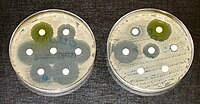
Photo from wikipedia
The silent pandemic of antimicrobial resistance (AR) has been on the rise for the past decades. It is essential to determine the burden of AR in animal farms that spreads… Click to show full abstract
The silent pandemic of antimicrobial resistance (AR) has been on the rise for the past decades. It is essential to determine the burden of AR in animal farms that spreads leading to human exposure. A total of 100 samples including soil, litter, animal excreta, and wastewater were collected from seven conventional and one organic farm in Egypt. The prevalence of extended-spectrum β-lactamase-producing Escherichia coli (ESBL-producing E. coli), fluoroquinolone-resistant E. coli, fluoroquinolone-resistant Salmonella, and vancomycin-resistant enterococci (VRE) was determined in studied farms. Conventional farms had a higher prevalence of antimicrobial-resistant bacteria than the organic farm (73.81% vs. 18.75%, P < .001). In conventional farms 21.43% of samples yielded mixed isolates; however, in the organic farm, only single isolates of ESBL-producing E. coli were detected. The most prevalent ESBL-production gene was blaTEM (82.14%), followed by blaCTX-M (48.22%), and blaSHV (19.64%), either alone or in combination with another gene. The most prevalent fluoroquinolone-resistance genes were qnrS (82.69%) and qnrB (42.30%), either alone or in combination with another gene(s). A total of five VRE isolates harbored vanA gene (83.33%), none carried vanB gene, and one isolate was negative for both genes. The studied conventional livestock farms had significantly higher rates of serious AR threats than the organic farm.
Journal Title: Letters in applied microbiology
Year Published: 2023
Link to full text (if available)
Share on Social Media: Sign Up to like & get
recommendations!